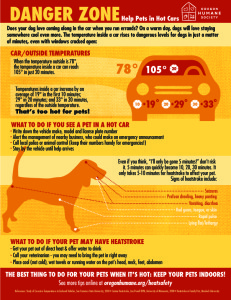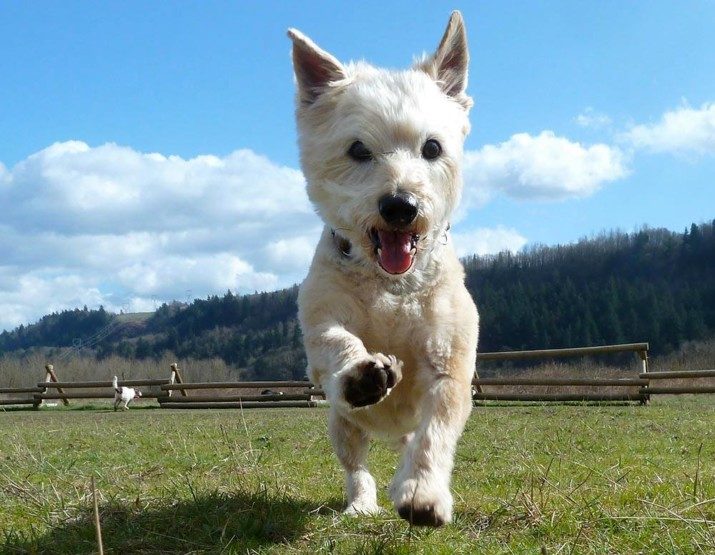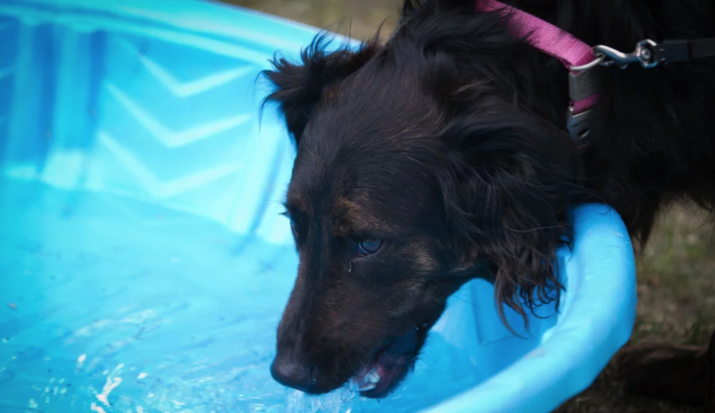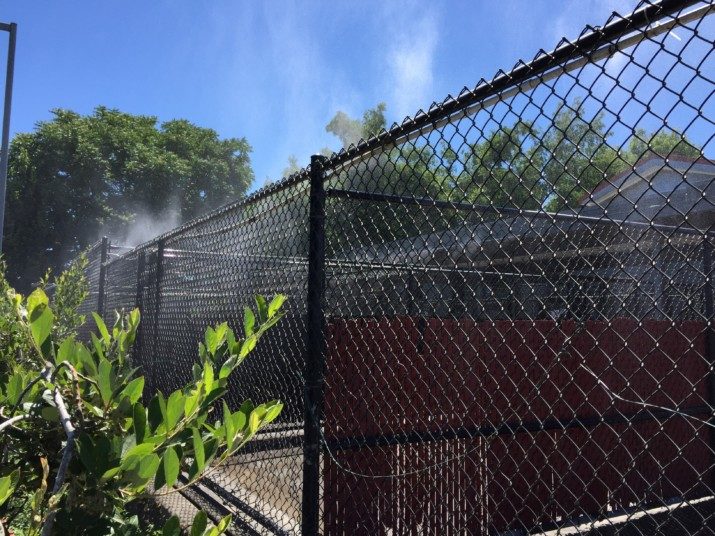Portland, OR. This stretch of hot weather can not only be uncomfortable for people, it can be dangerous for dogs, cats and other pets. The Oregon Humane Society urges animal lovers to follow these simple tips to keep their pets safe:
- Keep drinking water bowls full of cool, fresh water.
- Provide shaded areas where a pet can rest if outdoors.
- Keep an eye on pets around water—not all pets are natural swimmers.

If your pet is overcome by heat exhaustion, immediately immerse or spray the animal with cool running water (avoid cold water as that could cause shock) and continue until the body temperature lowers. Give your pet water to drink and consult your veterinarian right away to determine if additional treatment is needed.
- Do not leave pets unattended outside when it gets hot; bring them inside.
- Leave your pet at home when you are running errands – never leave your pet in the car when the weather is warm. Download an infographic that shows how hot a car can get.
- -colored pets can sunburn—check with your veterinarian before applying sunblock to your pet’s nose.
- High energy dogs will likely not have as much energy on a hot day, so lowering the normal level of activity is very important. Walk or exercise your dog when the temperature is cooler in the early morning and late evening.
- Brain work such as using puzzle toys and teaching a new trick can be a good way to keep a dog busy in an air conditioned environment.
- Making sure your dog stays hydrated, especially during exercise. Reduce activity and give your pet frequent breaks to rehydrate.
- Be aware of your pet’s specific needs based on age, level of fitness and breed.
Many dogs enjoy playing in a kiddie pool to keep cool.
More information about heat hazards for pets can be found on the OHS website.
If your home isn’t cool enough for you and your pets, options might include visiting a friend or family member, finding a doggie daycare for the day, or checking with your veterinarian or local animal services to see if they offer cooling stations. Plan ahead: know where you can go with your pets or arrange to have them stay during the heat.
If you see an animal in distress because of the heat, please take immediate steps to help, in addition to calling local police.
Provide the pet with a bowl of cool water; create a shady area where the animal can relax; set up a water sprinkler for the animal; knock on the doors of neighbors to see if anyone has access to the animal’s house. If possible, bring the pet indoors.
OHS and your local police agency typically can respond only to calls about pets who may not survive without immediate help.
If the animal is locked in a car, please see the section below about pets in vehicles.
Hot Weather Safety Advice
Heat and Sun Safety: Quick Tips
Fleas: Summer is also the worst time of year for fleas. If your dog or cat gets them, their whole environment must be treated, including the yard. Diatomaceous earth is a natural way to treat fleas in both indoor and outdoor environments, and can be found at most grocery stores. If your dog or cat and their environment are not treated, your pet may eat fleas, which could cause internal bodily harm (including tapeworms). You may want to contact your veterinarian to determine the best way to treat your pet for fleas directly.
Parked Cars and Other Vehicles

The Oregon Humane Society encourages you to leave your pet home and inside when you dash to the store or another errand. The inside of a car heats up very quickly. On an 85 degree day, a car’s interior temperature can climb to 120 degrees in 20 minutes, even with the windows slightly open.
What to do if you see a pet alone in a hot car:
Write down the car’s make, model and license plate number.
If there are businesses nearby, notify their managers or security personnel and ask them to make an announcement to find the car’s owner.
If the owner can’t be found, call the non-emergency number of the local police and/or animal control and wait by the car for them to arrive.
Can you break a car window to save a life?
The public, as well as police, can now break a car’s window to rescue a pet or child in imminent danger without fear of being sued for damages. The new law, which took effect in June of 2017, protects people from criminal and civil liability if they break a car window to save a child or animal who is left alone and appears to be in imminent danger. Breaking a window is a last resort: before a Good Samaritan chooses to break a car window, law enforcement must be contacted (call police or 911 in an emergency). Rescuers must stay with the animal until first responders arrive or the owner of the car returns. Be mindful that a dog or cat may feel protective of their space or even run off when faced with a stranger.
Heatstroke and Other Heat Emergencies
Symptoms of heatstroke include: restlessness, excessive thirst, heavy panting, lethargy, lack of appetite, dark tongue or gums, vomiting, lack of coordination or even collapse, and an internal temperature over 104° F.
Contact your veterinarian immediately if you notice these symptoms. Quick action could save your pet’s life.
Help your pet cool down: First, get your pet out of direct heat. Check for signs of shock and take your pet’s temperature if possible. Offer water to drink. Then: use a fan to blow cool air on the pet; place water-soaked towels (or running water) on the pet’s head, neck, feet, chest and abdomen; rub isopropyl alcohol (70%) on a dog’s footpads for cooling (do not allow dog to ingest). Do not use ice-cold water or ice—use cool water to avoid shock.
Safe cooling and consequences of heatstroke: “During a heat crisis, the goal is always to decrease the animal’s body temperature to 103° F in the first 10-15 minutes. Once 103° F is reached, you must stop the cooling process because the body temperature will continue to decrease and can plummet dangerously low if you continue to cool the dog for too long.
Even if you successfully cool your pet down to 103° F in the first 10-15 minutes, you must take the dog to a veterinarian as soon as possible because consequences of heat stroke will not show up for hours or even days. Potential problems include abnormal heart rhythms, kidney failure, neurological problems and respiratory arrest.” – from the American Red Cross
Highly susceptible pets: Animals with flat faces, like pugs and Persian cats, are more susceptible to heat stroke since they cannot pant as effectively. These pets, along with the elderly, the overweight, and those with heart or lung diseases, should be kept cool in air-conditioned rooms as much as possible. Note that a dog’s or cat’s normal body temperature is between 101 and 102 degrees.
If you see an animal in danger: If you suspect an emergency situation has developed and an animal (not your own) is in immediate danger from the heat, first consult the owner if possible and then contact your local animal control agency or local police department.
Hot Pavement
Pavement, asphalt, metal, and even sand that have been heated by the sun can burn dogs’ paw pads. Remember: if the surface is too hot for your bare hand or foot, it’s too hot for your dog’s feet.
Post-Swim Sensitivity: Pads can be soft and more sensitive after swimming, so take heed if your pup refuses to walk on the pavement after a swim.
Some ways to avoid pad burns:
- walk your dog early or late in the day, out of the heat
- walk frequently when it’s cool to build up callus on the pads
- walk on the grass when hot surfaces are unavoidable
- moisturize your dog’s pads daily with paw balms or creams
- lay down a wet towel for your dog to stand on when grassy areas are not available
Signs of burned pads include: limping or refusing to walk, licking or chewing at the feet, pads darker in color, missing part of pad, blisters or redness on the feet.
First aid for burned pads: keep the foot area cool and clean. Immediately flush with cool water and a gentle antibacterial such as betadine. Get the dog to a grassy area or if possible, carry him/her. Keep the dog from licking the wounds. For minor burns, spread the area with antibacterial ointment and cover with a loose bandage.
For serious burns, take the dog to your vet for further treatment. This is important to prevent infection and further damage.
Another concern is dogs riding on uncovered pickup beds. The sun heats up the metal truck bed and can burn your pet’s pads. Have Rover ride in the cab with you, put him in a secure crate, or please leave him at home and inside a cool place.
Generally speaking, keep your dogs off of hot surfaces whenever possible.
From OHS:
OHS is the largest humane society in the Northwest, and adopts more animals from its Portland shelter than any other single-facility shelter on the West Coast. OHS puts no time limits on how long animals remain at the shelter—a pet stays available for adoption for as long as needed to find a loving home. If a pet in the care of OHS needs medical attention, the OHS veterinary hospital provides the pet with same level of care you would want your own pet to receive.
Founded in 1868 by noted humanitarian Thomas Lamb Eliot, OHS is the third-oldest humane society in the nation and the oldest in the Northwest. Eliot initially established OHS to stop the neglect and abuse of draft animals. The mission expanded to include companion animals and, until 1933, orphaned children.
Community Services
- OHS finds homes for more than 11,000 pets each year
- OHS Humane Officers rescue neglected and abused animals, investigating approximately 1,000 cases annually
- The OHS medical team provides free and low-cost spay and neuter surgeries for thousands of pets owned by low-income families
- OHS educators reach more than 12,000 youths and about 2,000 adults annually through humane education programs
- The OHS Second Chance program brings more than 6,000 pets annually to OHS from other shelters around the region
- In the state capitol, OHS is the driving force behind efforts to improve laws that protect animals and punish offenders
Funding
- OHS receives no tax dollars
- OHS does not receive any portion of dues or donations paid to national organizations
- OHS is an Oregon nonprofit that relies on donations
- OHS operates independently of any other shelter group
- Financial information, including annual reports and audited statements, can be found here »
OHS Mission
To foster an environment of respect, responsibility and compassion for all animals through education, legislation and leadership. To care for the homeless, to defend the abused and to fight with unrelenting diligence for recognition of the integrity of all animals.


















